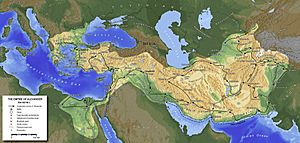Macedonia (ancient kingdom) facts for kids
Macedon or Macedonia was an old kingdom in northern Greece. It was located near other kingdoms like Epirus to its west and Thrace to its east.
For a long time, Macedon was the most powerful kingdom in the Near East and even reached parts of modern-day Pakistan. This happened after Alexander the Great conquered much of the world known to Europeans back then. This important time in Greek history is called the Hellenistic period. Later, the powerful Roman Empire took control of Macedon.
Contents
Who Were the Kings of Macedon?
Macedon had many kings from different royal families, also known as dynasties. These kings ruled for hundreds of years, shaping the kingdom's history and power.
The Argead Dynasty
The Argead family was the first major dynasty to rule Macedon. They were in charge for a very long time, from around 808 BC until 306 BC. Many famous kings came from this family, including Philip II and his son, Alexander the Great.
Here are some of the kings from the Argead Dynasty:
- Karanus (808-778 BC)
- Perdiccas I (700-678 BC)
- Alexander I (498-454 BC)
- Perdiccas II (454-413 BC)
- Archelaus (413-399 BC)
- Amyntas III (393 BC, then 392-370 BC)
- Philip II (359-336 BC) - He made Macedon very strong.
- Alexander III (the Great) (336-323 BC) - He built a huge empire.
- Antipater, who was a Regent (a ruler for a young king) of Macedon from 334-319 BC.
- Philip III Arrhidaeus (323-317 BC)
- Alexander IV (323-310 BC)
The Antipatrid Dynasty
After the Argead family, the Antipatrid Dynasty took over. This family was founded by Cassander, who was one of Alexander the Great's generals. They ruled for a shorter period.
Here are some kings from the Antipatrid Dynasty:
- Cassander (306-297 BC)
- Philip IV (297-296 BC)
- Alexander V (296-294 BC)
- Antipater II (296-294 BC)
The Antigonid Dynasty
The Antigonid Dynasty was another important family that ruled Macedon. They also came from one of Alexander the Great's generals, Antigonus I Monophthalmus. This dynasty ruled until Macedon was conquered by the Romans.
Here are some kings from the Antigonid Dynasty:
- Demetrius I Poliorcetes (294-288 BC)
- Lysimachus (288-281 BC) - He shared power with Pyrrhus of Epirus.
- Pyrrhus of Epirus (288-285 BC) - He also shared power.
- Antigonus II Gonatas (277-274 BC, then 272-239 BC)
- Demetrius II Aetolicus (239-229 BC)
- Antigonus III Doson (229-221 BC)
- Philip V (221-179 BC)
- Perseus (179-168 BC) - He was the last king of Macedon before the Romans took over.
Images for kids
-
The entrance to one of the royal tombs at Vergina, a UNESCO World Heritage Site
-
A silver octadrachm of Alexander I of Macedon, showing a figure on horseback with spears.
-
A Macedonian didrachm coin from the time of Archelaus I of Macedon.
-
A silver stater coin of Amyntas III of Macedon.
-
A golden stater coin of Philip III Arrhidaeus with images of Athena and Nike.
-
The Temple of Apollo at Corinth, with the Acrocorinth in the background.
-
A map showing the Kingdom of Macedonia (orange) under Philip V of Macedon.
-
A tetradrachm coin of Philip V of Macedon, showing the king's portrait.
-
Bronze bust of Eumenes II of Pergamon, a Roman copy of a Greek original.
-
The Vergina Sun, a star symbol found on the burial chest of Philip II of Macedon.
-
A fresco showing Hades taking Persephone, from a royal tomb at Vergina.
-
Fresco of an ancient Macedonian soldier wearing chainmail armor and holding a shield.
-
A mosaic from the Kasta Tomb showing the abduction of Persephone by Pluto.
-
A portrait bust of Aristotle, a Roman copy of a Greek sculpture.
-
A fresco showing Hades and Persephone in a chariot, from a tomb at Vergina.
-
Ruins of the ancient theatre in Maroneia.
-
Tetradrachms and drachms (coins) from the time of Alexander the Great.
-
The Alexander Mosaic, a Roman mosaic showing a battle scene.
See also
 In Spanish: Reino de Macedonia para niños
In Spanish: Reino de Macedonia para niños




















